Performance Related Pay: Concepts, Theories, and Effectiveness
VerifiedAdded on 2021/04/17
|16
|3449
|39
Report
AI Summary
This report provides a comprehensive analysis of performance-related pay (PRP) in human resource management. It begins by defining PRP and exploring key concepts such as performance planning, reward systems, and evaluation methods. The report then delves into various theories of motivation, including content theories (Maslow, Herzberg) and process theories (Adams, Vroom), and their connection to PRP. It examines the effectiveness of PRP systems in different industries, specifically the manufacturing and hospitality sectors, highlighting how incentive plans are tailored to each industry's unique characteristics and goals. The report also discusses the benefits of PRP, such as increased employee motivation and productivity, while also acknowledging potential issues such as insufficient rewards and lack of employee support. The report concludes by emphasizing the importance of transparency, clear objectives, and employee involvement in the successful implementation of PRP systems. The report aims to evaluate the effectiveness of the performance related pay because every industry has its own way to evaluate the performance of the employees and the incentives plan. PRP encourages employee of the organization to earn more money.
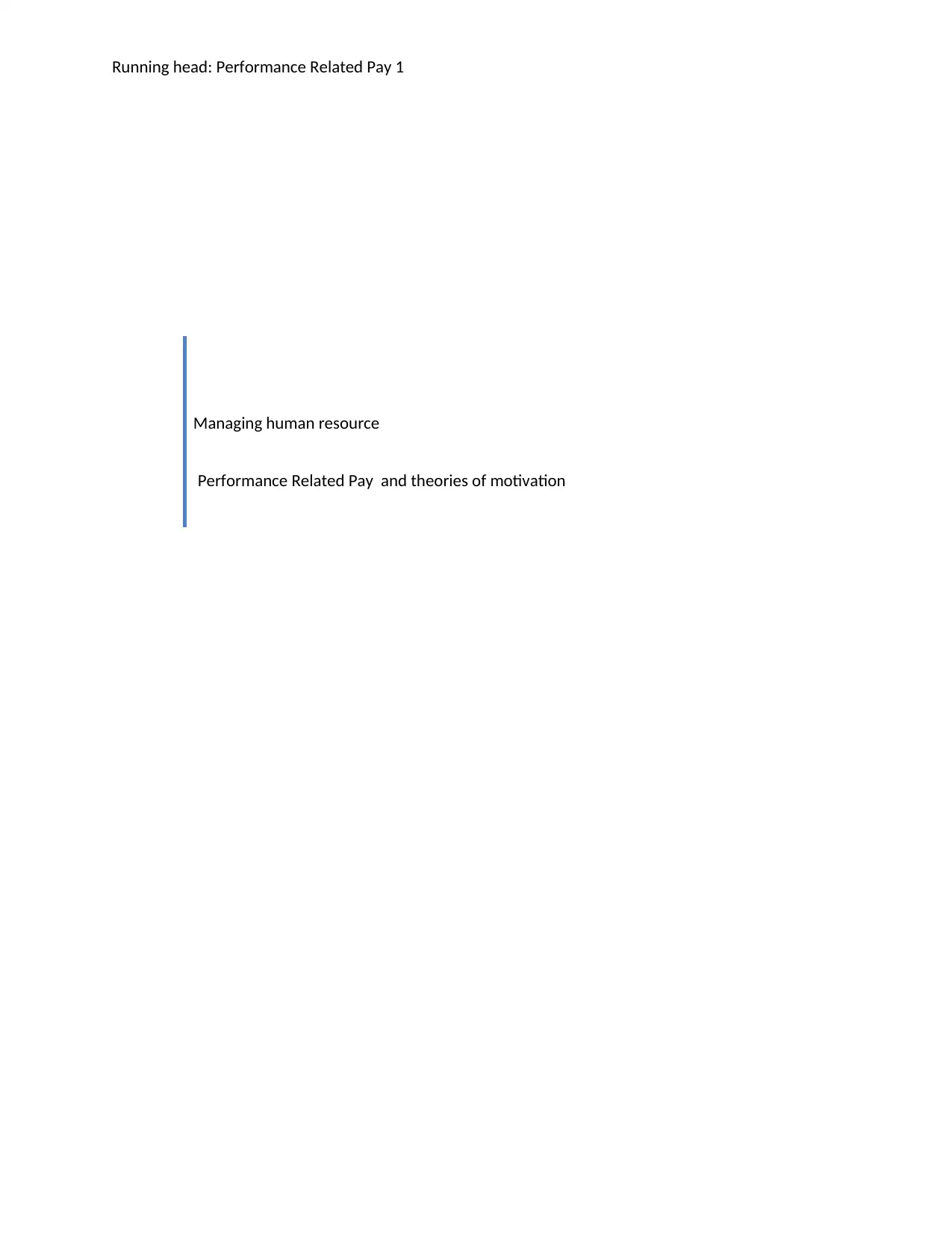
Running head: Performance Related Pay 1
Managing human resource
Performance Related Pay and theories of motivation
Managing human resource
Performance Related Pay and theories of motivation
Paraphrase This Document
Need a fresh take? Get an instant paraphrase of this document with our AI Paraphraser
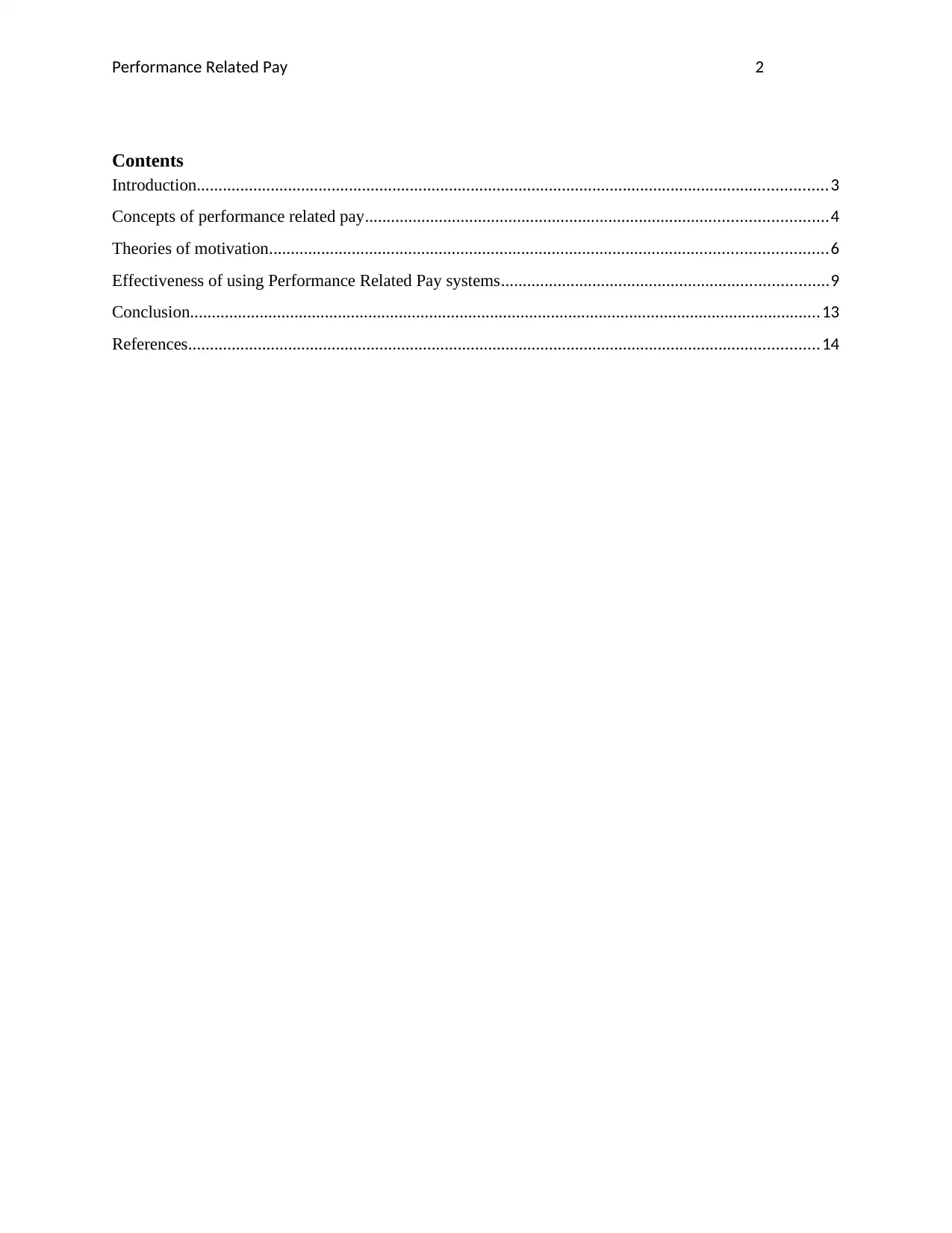
Performance Related Pay 2
Contents
Introduction.................................................................................................................................................3
Concepts of performance related pay..........................................................................................................4
Theories of motivation................................................................................................................................6
Effectiveness of using Performance Related Pay systems...........................................................................9
Conclusion.................................................................................................................................................13
References.................................................................................................................................................14
Contents
Introduction.................................................................................................................................................3
Concepts of performance related pay..........................................................................................................4
Theories of motivation................................................................................................................................6
Effectiveness of using Performance Related Pay systems...........................................................................9
Conclusion.................................................................................................................................................13
References.................................................................................................................................................14
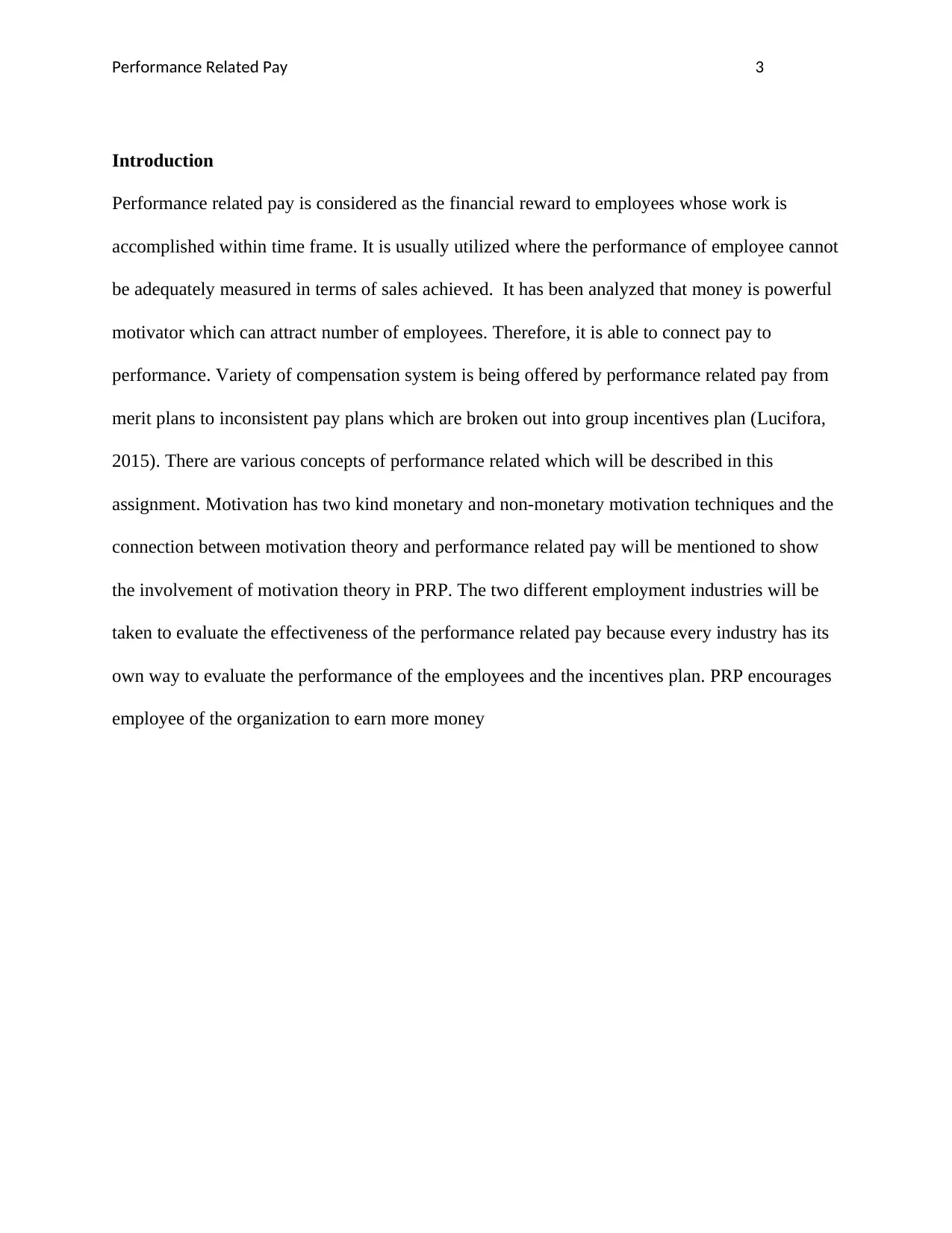
Performance Related Pay 3
Introduction
Performance related pay is considered as the financial reward to employees whose work is
accomplished within time frame. It is usually utilized where the performance of employee cannot
be adequately measured in terms of sales achieved. It has been analyzed that money is powerful
motivator which can attract number of employees. Therefore, it is able to connect pay to
performance. Variety of compensation system is being offered by performance related pay from
merit plans to inconsistent pay plans which are broken out into group incentives plan (Lucifora,
2015). There are various concepts of performance related which will be described in this
assignment. Motivation has two kind monetary and non-monetary motivation techniques and the
connection between motivation theory and performance related pay will be mentioned to show
the involvement of motivation theory in PRP. The two different employment industries will be
taken to evaluate the effectiveness of the performance related pay because every industry has its
own way to evaluate the performance of the employees and the incentives plan. PRP encourages
employee of the organization to earn more money
Introduction
Performance related pay is considered as the financial reward to employees whose work is
accomplished within time frame. It is usually utilized where the performance of employee cannot
be adequately measured in terms of sales achieved. It has been analyzed that money is powerful
motivator which can attract number of employees. Therefore, it is able to connect pay to
performance. Variety of compensation system is being offered by performance related pay from
merit plans to inconsistent pay plans which are broken out into group incentives plan (Lucifora,
2015). There are various concepts of performance related which will be described in this
assignment. Motivation has two kind monetary and non-monetary motivation techniques and the
connection between motivation theory and performance related pay will be mentioned to show
the involvement of motivation theory in PRP. The two different employment industries will be
taken to evaluate the effectiveness of the performance related pay because every industry has its
own way to evaluate the performance of the employees and the incentives plan. PRP encourages
employee of the organization to earn more money
⊘ This is a preview!⊘
Do you want full access?
Subscribe today to unlock all pages.

Trusted by 1+ million students worldwide
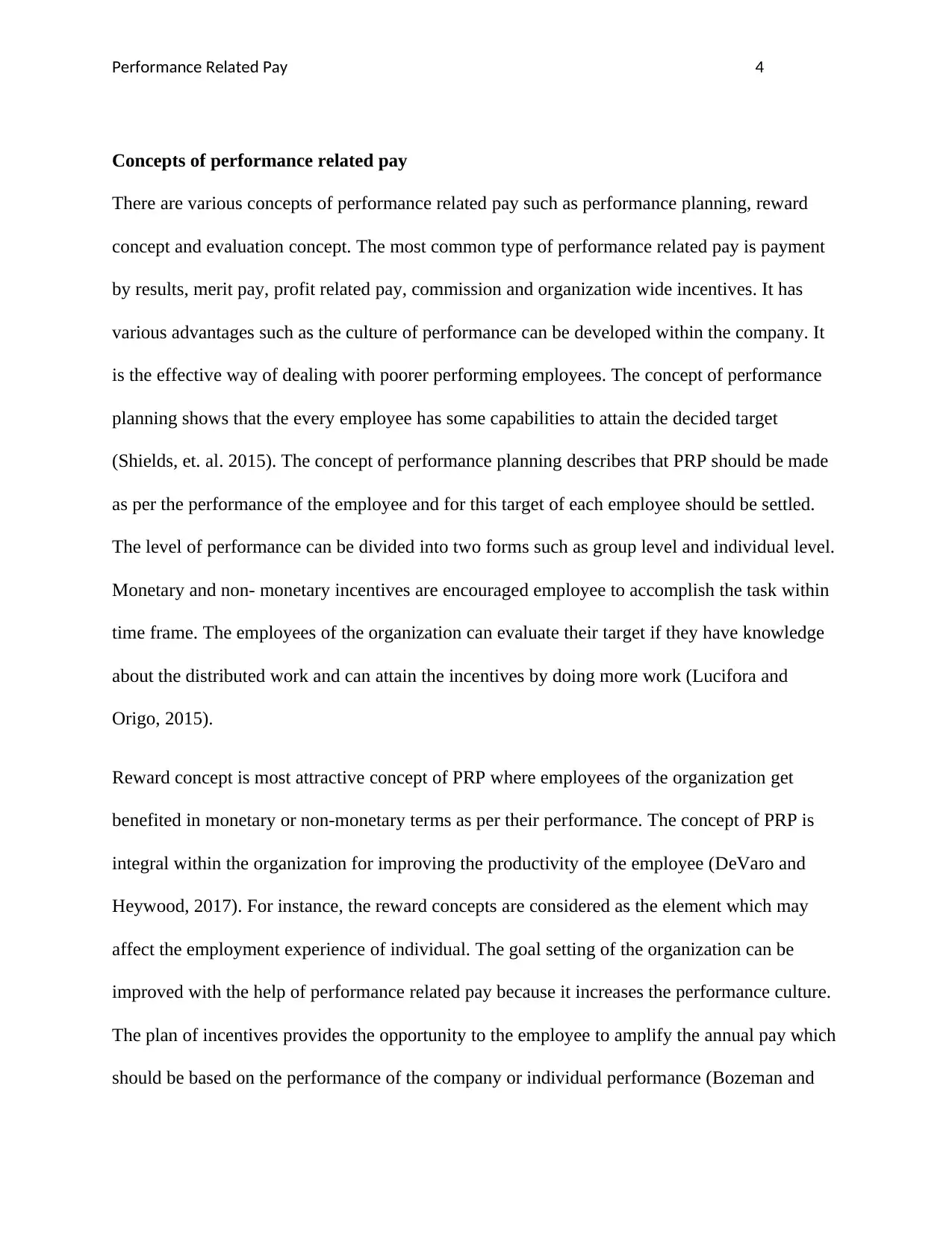
Performance Related Pay 4
Concepts of performance related pay
There are various concepts of performance related pay such as performance planning, reward
concept and evaluation concept. The most common type of performance related pay is payment
by results, merit pay, profit related pay, commission and organization wide incentives. It has
various advantages such as the culture of performance can be developed within the company. It
is the effective way of dealing with poorer performing employees. The concept of performance
planning shows that the every employee has some capabilities to attain the decided target
(Shields, et. al. 2015). The concept of performance planning describes that PRP should be made
as per the performance of the employee and for this target of each employee should be settled.
The level of performance can be divided into two forms such as group level and individual level.
Monetary and non- monetary incentives are encouraged employee to accomplish the task within
time frame. The employees of the organization can evaluate their target if they have knowledge
about the distributed work and can attain the incentives by doing more work (Lucifora and
Origo, 2015).
Reward concept is most attractive concept of PRP where employees of the organization get
benefited in monetary or non-monetary terms as per their performance. The concept of PRP is
integral within the organization for improving the productivity of the employee (DeVaro and
Heywood, 2017). For instance, the reward concepts are considered as the element which may
affect the employment experience of individual. The goal setting of the organization can be
improved with the help of performance related pay because it increases the performance culture.
The plan of incentives provides the opportunity to the employee to amplify the annual pay which
should be based on the performance of the company or individual performance (Bozeman and
Concepts of performance related pay
There are various concepts of performance related pay such as performance planning, reward
concept and evaluation concept. The most common type of performance related pay is payment
by results, merit pay, profit related pay, commission and organization wide incentives. It has
various advantages such as the culture of performance can be developed within the company. It
is the effective way of dealing with poorer performing employees. The concept of performance
planning shows that the every employee has some capabilities to attain the decided target
(Shields, et. al. 2015). The concept of performance planning describes that PRP should be made
as per the performance of the employee and for this target of each employee should be settled.
The level of performance can be divided into two forms such as group level and individual level.
Monetary and non- monetary incentives are encouraged employee to accomplish the task within
time frame. The employees of the organization can evaluate their target if they have knowledge
about the distributed work and can attain the incentives by doing more work (Lucifora and
Origo, 2015).
Reward concept is most attractive concept of PRP where employees of the organization get
benefited in monetary or non-monetary terms as per their performance. The concept of PRP is
integral within the organization for improving the productivity of the employee (DeVaro and
Heywood, 2017). For instance, the reward concepts are considered as the element which may
affect the employment experience of individual. The goal setting of the organization can be
improved with the help of performance related pay because it increases the performance culture.
The plan of incentives provides the opportunity to the employee to amplify the annual pay which
should be based on the performance of the company or individual performance (Bozeman and
Paraphrase This Document
Need a fresh take? Get an instant paraphrase of this document with our AI Paraphraser
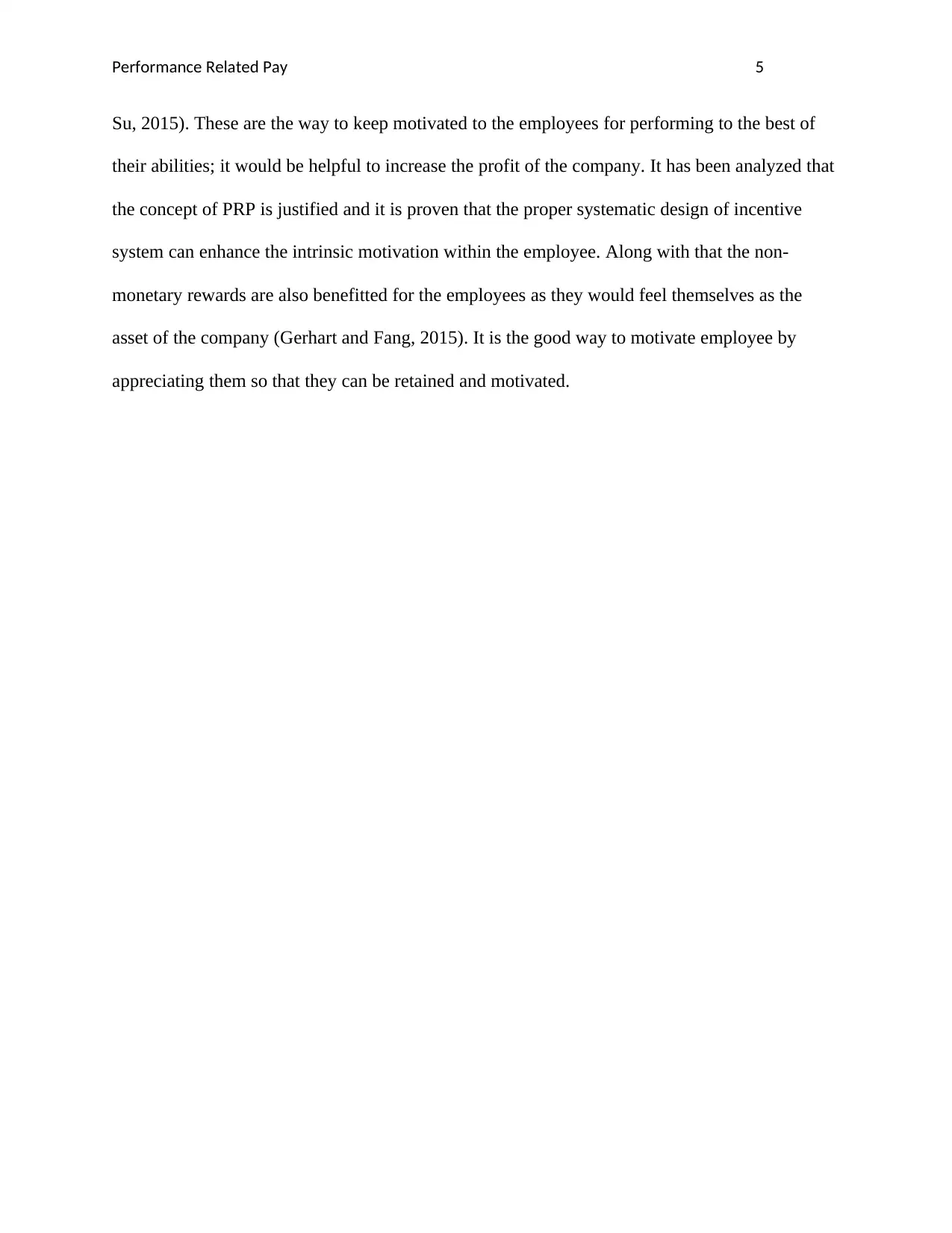
Performance Related Pay 5
Su, 2015). These are the way to keep motivated to the employees for performing to the best of
their abilities; it would be helpful to increase the profit of the company. It has been analyzed that
the concept of PRP is justified and it is proven that the proper systematic design of incentive
system can enhance the intrinsic motivation within the employee. Along with that the non-
monetary rewards are also benefitted for the employees as they would feel themselves as the
asset of the company (Gerhart and Fang, 2015). It is the good way to motivate employee by
appreciating them so that they can be retained and motivated.
Su, 2015). These are the way to keep motivated to the employees for performing to the best of
their abilities; it would be helpful to increase the profit of the company. It has been analyzed that
the concept of PRP is justified and it is proven that the proper systematic design of incentive
system can enhance the intrinsic motivation within the employee. Along with that the non-
monetary rewards are also benefitted for the employees as they would feel themselves as the
asset of the company (Gerhart and Fang, 2015). It is the good way to motivate employee by
appreciating them so that they can be retained and motivated.
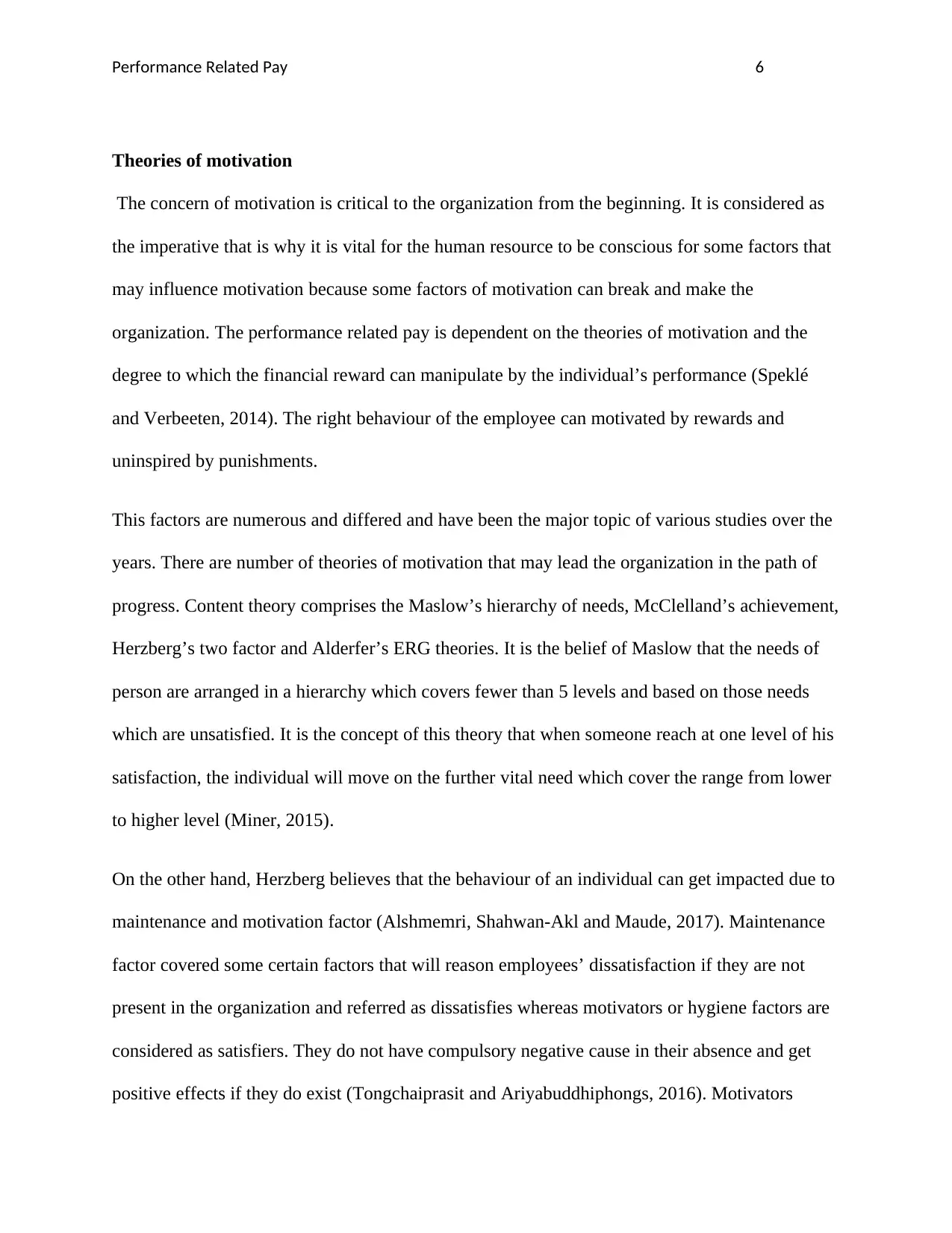
Performance Related Pay 6
Theories of motivation
The concern of motivation is critical to the organization from the beginning. It is considered as
the imperative that is why it is vital for the human resource to be conscious for some factors that
may influence motivation because some factors of motivation can break and make the
organization. The performance related pay is dependent on the theories of motivation and the
degree to which the financial reward can manipulate by the individual’s performance (Speklé
and Verbeeten, 2014). The right behaviour of the employee can motivated by rewards and
uninspired by punishments.
This factors are numerous and differed and have been the major topic of various studies over the
years. There are number of theories of motivation that may lead the organization in the path of
progress. Content theory comprises the Maslow’s hierarchy of needs, McClelland’s achievement,
Herzberg’s two factor and Alderfer’s ERG theories. It is the belief of Maslow that the needs of
person are arranged in a hierarchy which covers fewer than 5 levels and based on those needs
which are unsatisfied. It is the concept of this theory that when someone reach at one level of his
satisfaction, the individual will move on the further vital need which cover the range from lower
to higher level (Miner, 2015).
On the other hand, Herzberg believes that the behaviour of an individual can get impacted due to
maintenance and motivation factor (Alshmemri, Shahwan-Akl and Maude, 2017). Maintenance
factor covered some certain factors that will reason employees’ dissatisfaction if they are not
present in the organization and referred as dissatisfies whereas motivators or hygiene factors are
considered as satisfiers. They do not have compulsory negative cause in their absence and get
positive effects if they do exist (Tongchaiprasit and Ariyabuddhiphongs, 2016). Motivators
Theories of motivation
The concern of motivation is critical to the organization from the beginning. It is considered as
the imperative that is why it is vital for the human resource to be conscious for some factors that
may influence motivation because some factors of motivation can break and make the
organization. The performance related pay is dependent on the theories of motivation and the
degree to which the financial reward can manipulate by the individual’s performance (Speklé
and Verbeeten, 2014). The right behaviour of the employee can motivated by rewards and
uninspired by punishments.
This factors are numerous and differed and have been the major topic of various studies over the
years. There are number of theories of motivation that may lead the organization in the path of
progress. Content theory comprises the Maslow’s hierarchy of needs, McClelland’s achievement,
Herzberg’s two factor and Alderfer’s ERG theories. It is the belief of Maslow that the needs of
person are arranged in a hierarchy which covers fewer than 5 levels and based on those needs
which are unsatisfied. It is the concept of this theory that when someone reach at one level of his
satisfaction, the individual will move on the further vital need which cover the range from lower
to higher level (Miner, 2015).
On the other hand, Herzberg believes that the behaviour of an individual can get impacted due to
maintenance and motivation factor (Alshmemri, Shahwan-Akl and Maude, 2017). Maintenance
factor covered some certain factors that will reason employees’ dissatisfaction if they are not
present in the organization and referred as dissatisfies whereas motivators or hygiene factors are
considered as satisfiers. They do not have compulsory negative cause in their absence and get
positive effects if they do exist (Tongchaiprasit and Ariyabuddhiphongs, 2016). Motivators
⊘ This is a preview!⊘
Do you want full access?
Subscribe today to unlock all pages.

Trusted by 1+ million students worldwide
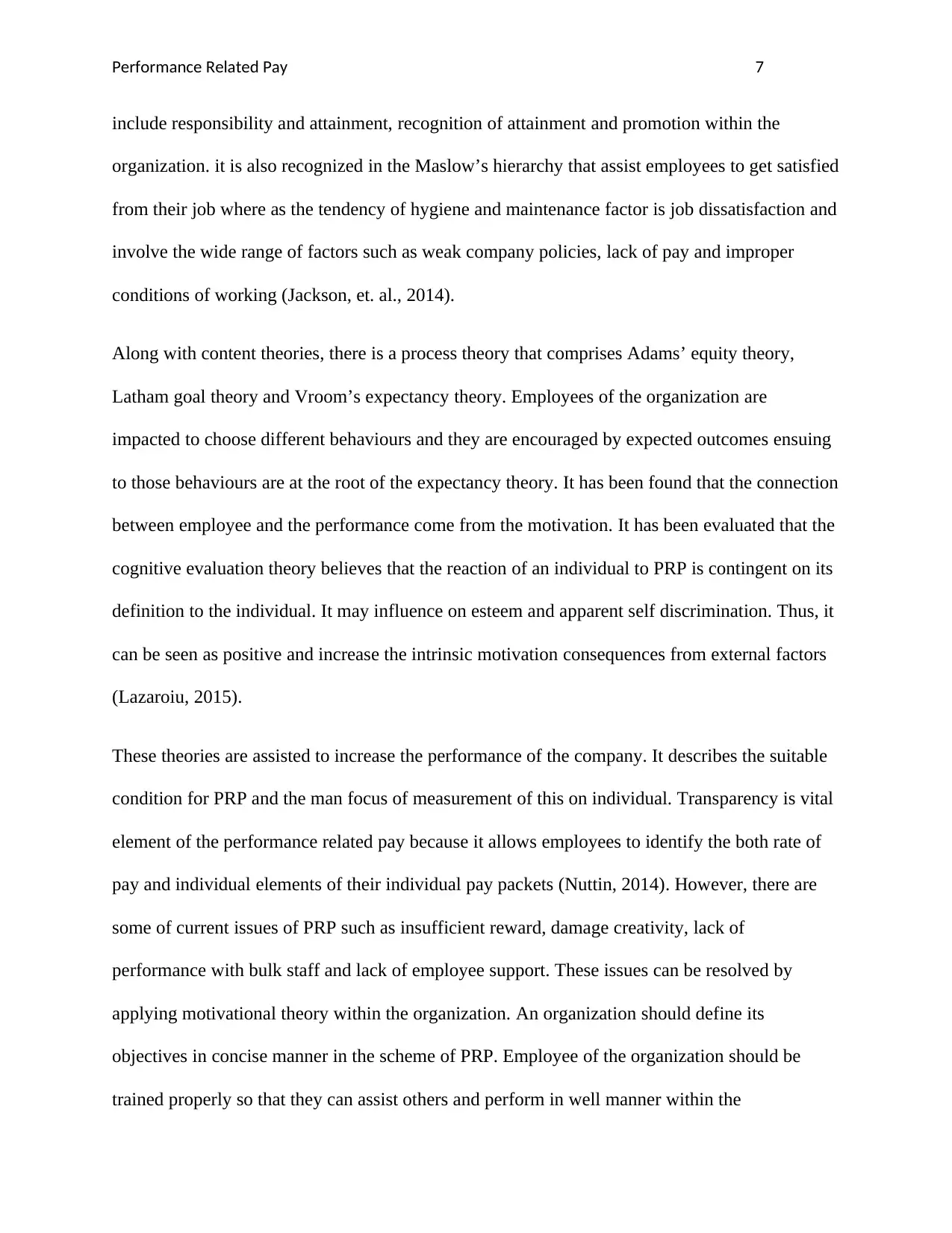
Performance Related Pay 7
include responsibility and attainment, recognition of attainment and promotion within the
organization. it is also recognized in the Maslow’s hierarchy that assist employees to get satisfied
from their job where as the tendency of hygiene and maintenance factor is job dissatisfaction and
involve the wide range of factors such as weak company policies, lack of pay and improper
conditions of working (Jackson, et. al., 2014).
Along with content theories, there is a process theory that comprises Adams’ equity theory,
Latham goal theory and Vroom’s expectancy theory. Employees of the organization are
impacted to choose different behaviours and they are encouraged by expected outcomes ensuing
to those behaviours are at the root of the expectancy theory. It has been found that the connection
between employee and the performance come from the motivation. It has been evaluated that the
cognitive evaluation theory believes that the reaction of an individual to PRP is contingent on its
definition to the individual. It may influence on esteem and apparent self discrimination. Thus, it
can be seen as positive and increase the intrinsic motivation consequences from external factors
(Lazaroiu, 2015).
These theories are assisted to increase the performance of the company. It describes the suitable
condition for PRP and the man focus of measurement of this on individual. Transparency is vital
element of the performance related pay because it allows employees to identify the both rate of
pay and individual elements of their individual pay packets (Nuttin, 2014). However, there are
some of current issues of PRP such as insufficient reward, damage creativity, lack of
performance with bulk staff and lack of employee support. These issues can be resolved by
applying motivational theory within the organization. An organization should define its
objectives in concise manner in the scheme of PRP. Employee of the organization should be
trained properly so that they can assist others and perform in well manner within the
include responsibility and attainment, recognition of attainment and promotion within the
organization. it is also recognized in the Maslow’s hierarchy that assist employees to get satisfied
from their job where as the tendency of hygiene and maintenance factor is job dissatisfaction and
involve the wide range of factors such as weak company policies, lack of pay and improper
conditions of working (Jackson, et. al., 2014).
Along with content theories, there is a process theory that comprises Adams’ equity theory,
Latham goal theory and Vroom’s expectancy theory. Employees of the organization are
impacted to choose different behaviours and they are encouraged by expected outcomes ensuing
to those behaviours are at the root of the expectancy theory. It has been found that the connection
between employee and the performance come from the motivation. It has been evaluated that the
cognitive evaluation theory believes that the reaction of an individual to PRP is contingent on its
definition to the individual. It may influence on esteem and apparent self discrimination. Thus, it
can be seen as positive and increase the intrinsic motivation consequences from external factors
(Lazaroiu, 2015).
These theories are assisted to increase the performance of the company. It describes the suitable
condition for PRP and the man focus of measurement of this on individual. Transparency is vital
element of the performance related pay because it allows employees to identify the both rate of
pay and individual elements of their individual pay packets (Nuttin, 2014). However, there are
some of current issues of PRP such as insufficient reward, damage creativity, lack of
performance with bulk staff and lack of employee support. These issues can be resolved by
applying motivational theory within the organization. An organization should define its
objectives in concise manner in the scheme of PRP. Employee of the organization should be
trained properly so that they can assist others and perform in well manner within the
Paraphrase This Document
Need a fresh take? Get an instant paraphrase of this document with our AI Paraphraser
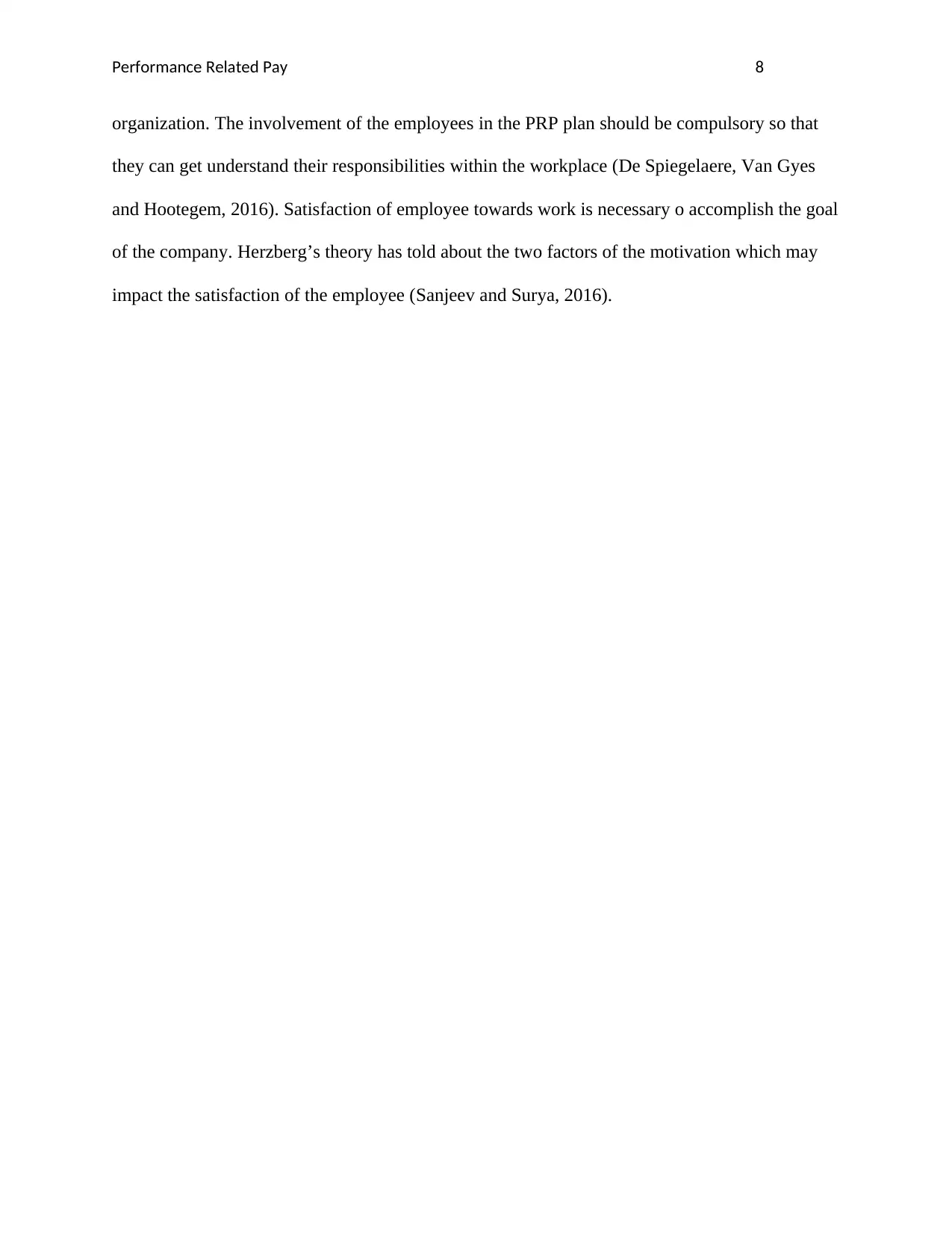
Performance Related Pay 8
organization. The involvement of the employees in the PRP plan should be compulsory so that
they can get understand their responsibilities within the workplace (De Spiegelaere, Van Gyes
and Hootegem, 2016). Satisfaction of employee towards work is necessary o accomplish the goal
of the company. Herzberg’s theory has told about the two factors of the motivation which may
impact the satisfaction of the employee (Sanjeev and Surya, 2016).
organization. The involvement of the employees in the PRP plan should be compulsory so that
they can get understand their responsibilities within the workplace (De Spiegelaere, Van Gyes
and Hootegem, 2016). Satisfaction of employee towards work is necessary o accomplish the goal
of the company. Herzberg’s theory has told about the two factors of the motivation which may
impact the satisfaction of the employee (Sanjeev and Surya, 2016).
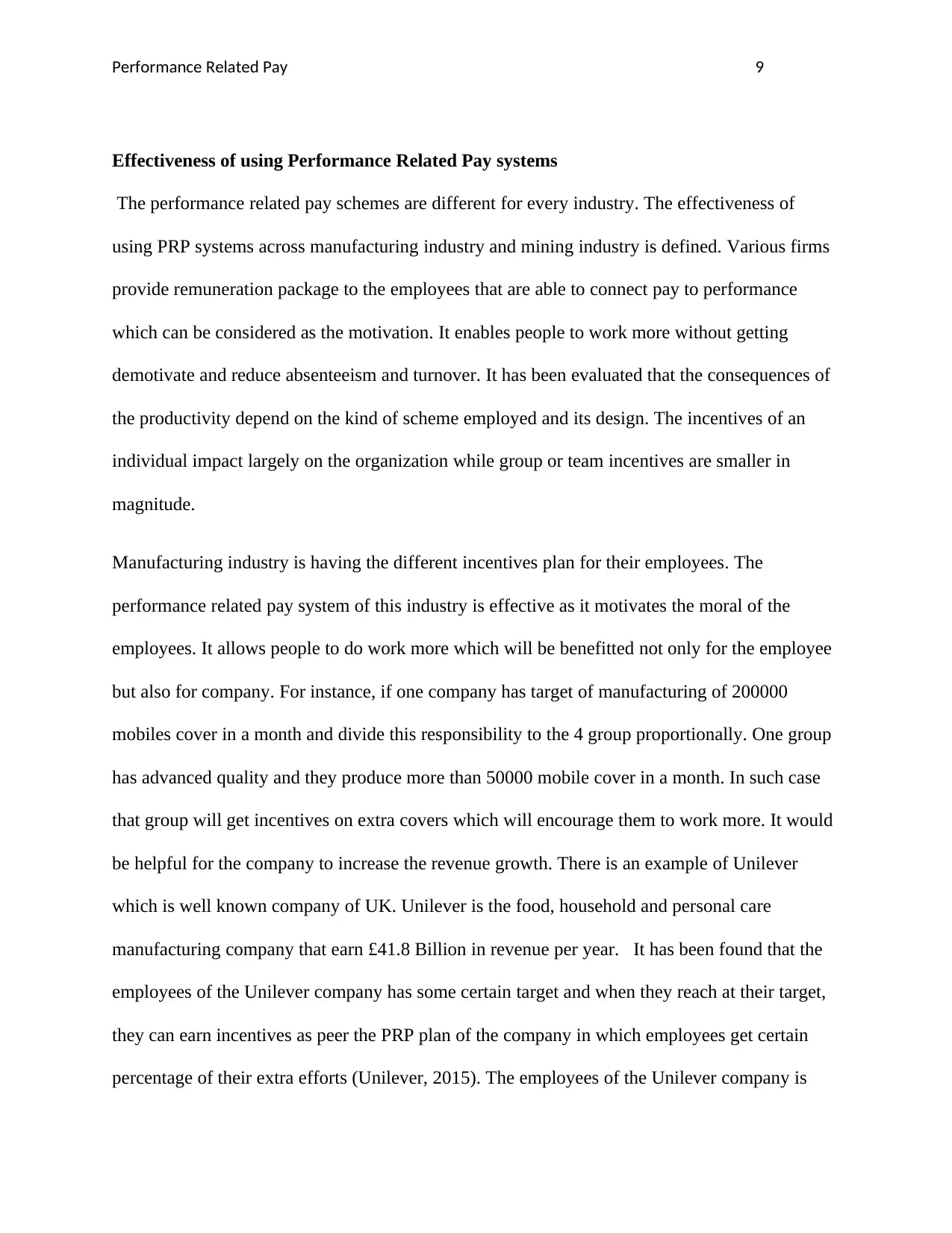
Performance Related Pay 9
Effectiveness of using Performance Related Pay systems
The performance related pay schemes are different for every industry. The effectiveness of
using PRP systems across manufacturing industry and mining industry is defined. Various firms
provide remuneration package to the employees that are able to connect pay to performance
which can be considered as the motivation. It enables people to work more without getting
demotivate and reduce absenteeism and turnover. It has been evaluated that the consequences of
the productivity depend on the kind of scheme employed and its design. The incentives of an
individual impact largely on the organization while group or team incentives are smaller in
magnitude.
Manufacturing industry is having the different incentives plan for their employees. The
performance related pay system of this industry is effective as it motivates the moral of the
employees. It allows people to do work more which will be benefitted not only for the employee
but also for company. For instance, if one company has target of manufacturing of 200000
mobiles cover in a month and divide this responsibility to the 4 group proportionally. One group
has advanced quality and they produce more than 50000 mobile cover in a month. In such case
that group will get incentives on extra covers which will encourage them to work more. It would
be helpful for the company to increase the revenue growth. There is an example of Unilever
which is well known company of UK. Unilever is the food, household and personal care
manufacturing company that earn £41.8 Billion in revenue per year. It has been found that the
employees of the Unilever company has some certain target and when they reach at their target,
they can earn incentives as peer the PRP plan of the company in which employees get certain
percentage of their extra efforts (Unilever, 2015). The employees of the Unilever company is
Effectiveness of using Performance Related Pay systems
The performance related pay schemes are different for every industry. The effectiveness of
using PRP systems across manufacturing industry and mining industry is defined. Various firms
provide remuneration package to the employees that are able to connect pay to performance
which can be considered as the motivation. It enables people to work more without getting
demotivate and reduce absenteeism and turnover. It has been evaluated that the consequences of
the productivity depend on the kind of scheme employed and its design. The incentives of an
individual impact largely on the organization while group or team incentives are smaller in
magnitude.
Manufacturing industry is having the different incentives plan for their employees. The
performance related pay system of this industry is effective as it motivates the moral of the
employees. It allows people to do work more which will be benefitted not only for the employee
but also for company. For instance, if one company has target of manufacturing of 200000
mobiles cover in a month and divide this responsibility to the 4 group proportionally. One group
has advanced quality and they produce more than 50000 mobile cover in a month. In such case
that group will get incentives on extra covers which will encourage them to work more. It would
be helpful for the company to increase the revenue growth. There is an example of Unilever
which is well known company of UK. Unilever is the food, household and personal care
manufacturing company that earn £41.8 Billion in revenue per year. It has been found that the
employees of the Unilever company has some certain target and when they reach at their target,
they can earn incentives as peer the PRP plan of the company in which employees get certain
percentage of their extra efforts (Unilever, 2015). The employees of the Unilever company is
⊘ This is a preview!⊘
Do you want full access?
Subscribe today to unlock all pages.

Trusted by 1+ million students worldwide
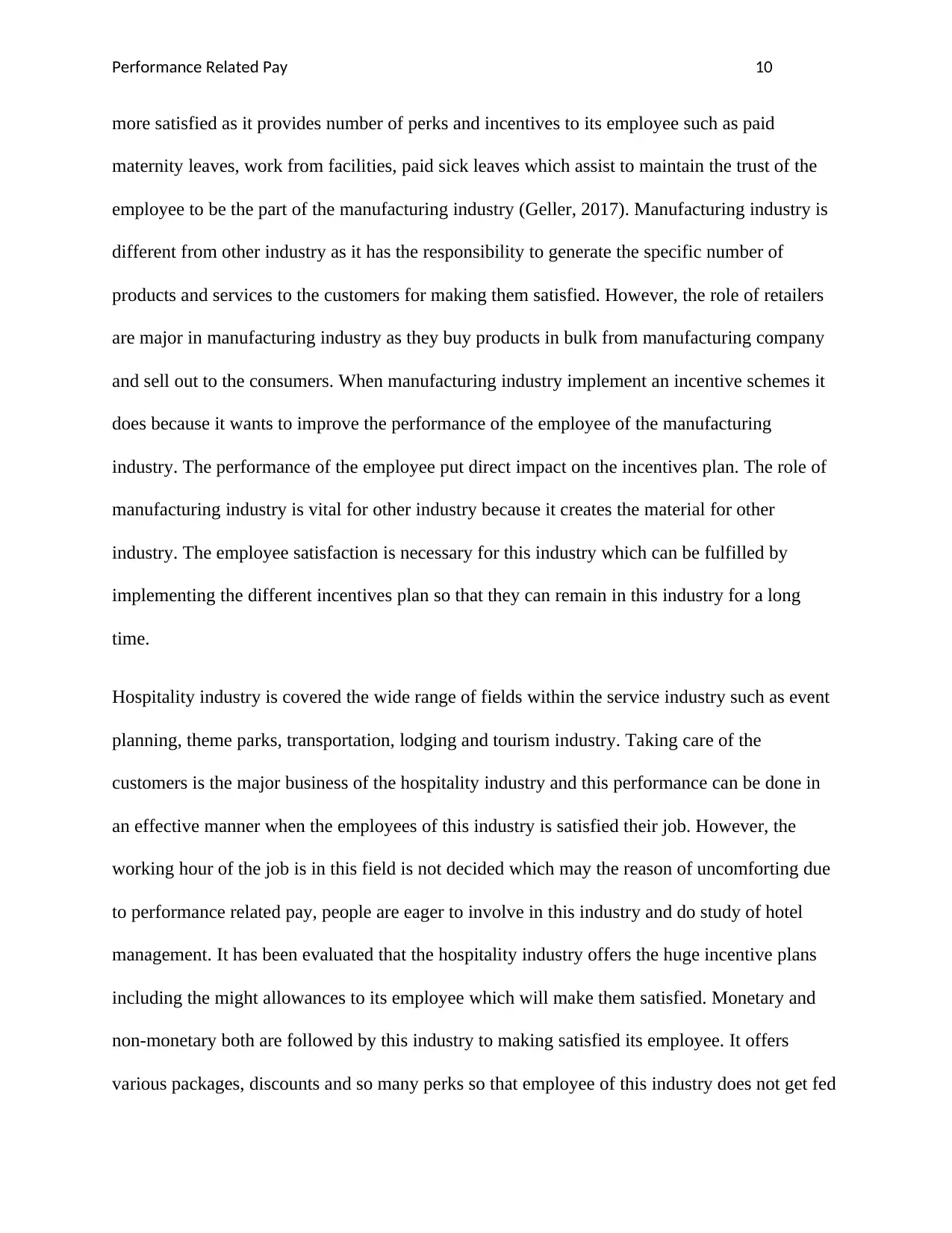
Performance Related Pay 10
more satisfied as it provides number of perks and incentives to its employee such as paid
maternity leaves, work from facilities, paid sick leaves which assist to maintain the trust of the
employee to be the part of the manufacturing industry (Geller, 2017). Manufacturing industry is
different from other industry as it has the responsibility to generate the specific number of
products and services to the customers for making them satisfied. However, the role of retailers
are major in manufacturing industry as they buy products in bulk from manufacturing company
and sell out to the consumers. When manufacturing industry implement an incentive schemes it
does because it wants to improve the performance of the employee of the manufacturing
industry. The performance of the employee put direct impact on the incentives plan. The role of
manufacturing industry is vital for other industry because it creates the material for other
industry. The employee satisfaction is necessary for this industry which can be fulfilled by
implementing the different incentives plan so that they can remain in this industry for a long
time.
Hospitality industry is covered the wide range of fields within the service industry such as event
planning, theme parks, transportation, lodging and tourism industry. Taking care of the
customers is the major business of the hospitality industry and this performance can be done in
an effective manner when the employees of this industry is satisfied their job. However, the
working hour of the job is in this field is not decided which may the reason of uncomforting due
to performance related pay, people are eager to involve in this industry and do study of hotel
management. It has been evaluated that the hospitality industry offers the huge incentive plans
including the might allowances to its employee which will make them satisfied. Monetary and
non-monetary both are followed by this industry to making satisfied its employee. It offers
various packages, discounts and so many perks so that employee of this industry does not get fed
more satisfied as it provides number of perks and incentives to its employee such as paid
maternity leaves, work from facilities, paid sick leaves which assist to maintain the trust of the
employee to be the part of the manufacturing industry (Geller, 2017). Manufacturing industry is
different from other industry as it has the responsibility to generate the specific number of
products and services to the customers for making them satisfied. However, the role of retailers
are major in manufacturing industry as they buy products in bulk from manufacturing company
and sell out to the consumers. When manufacturing industry implement an incentive schemes it
does because it wants to improve the performance of the employee of the manufacturing
industry. The performance of the employee put direct impact on the incentives plan. The role of
manufacturing industry is vital for other industry because it creates the material for other
industry. The employee satisfaction is necessary for this industry which can be fulfilled by
implementing the different incentives plan so that they can remain in this industry for a long
time.
Hospitality industry is covered the wide range of fields within the service industry such as event
planning, theme parks, transportation, lodging and tourism industry. Taking care of the
customers is the major business of the hospitality industry and this performance can be done in
an effective manner when the employees of this industry is satisfied their job. However, the
working hour of the job is in this field is not decided which may the reason of uncomforting due
to performance related pay, people are eager to involve in this industry and do study of hotel
management. It has been evaluated that the hospitality industry offers the huge incentive plans
including the might allowances to its employee which will make them satisfied. Monetary and
non-monetary both are followed by this industry to making satisfied its employee. It offers
various packages, discounts and so many perks so that employee of this industry does not get fed
Paraphrase This Document
Need a fresh take? Get an instant paraphrase of this document with our AI Paraphraser
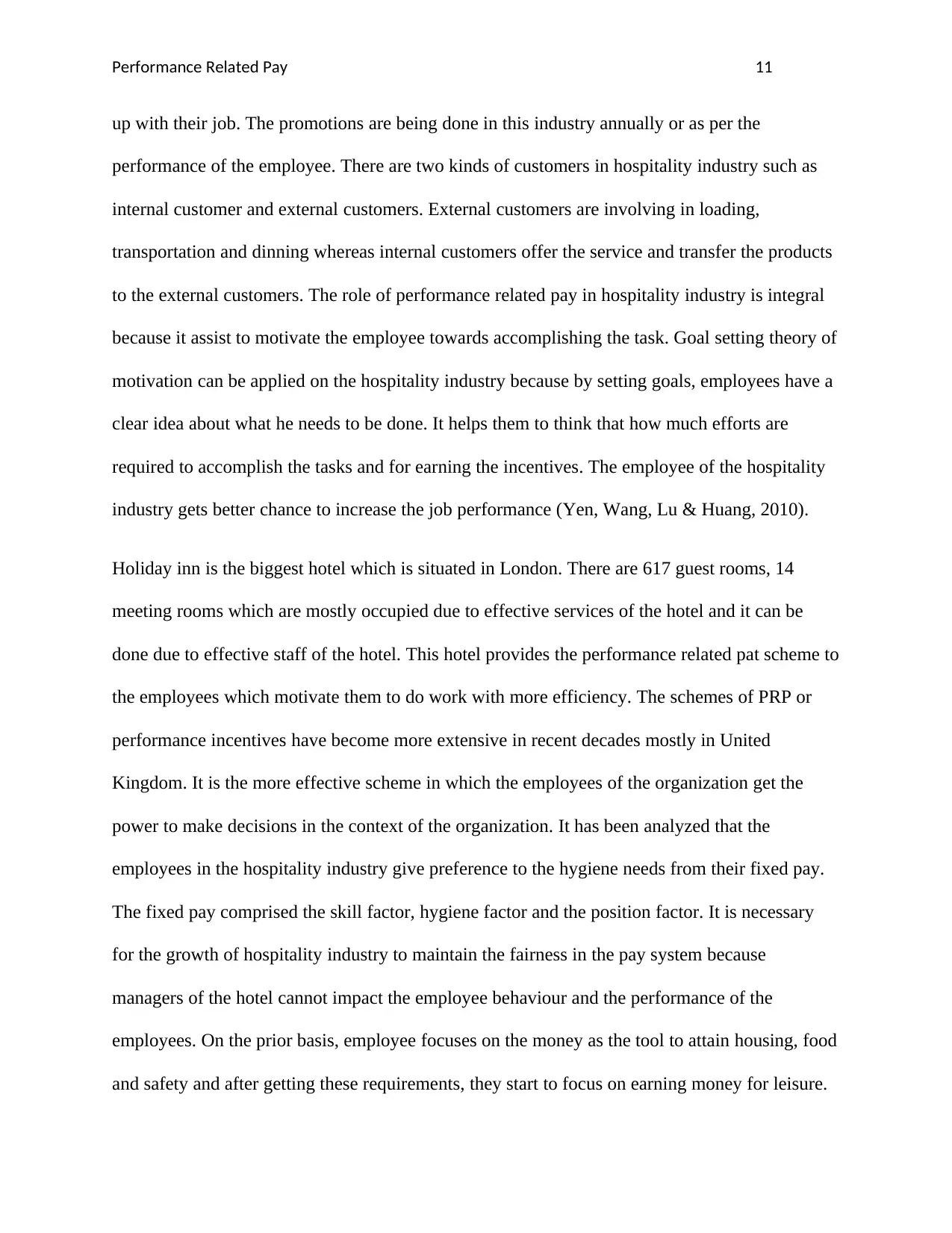
Performance Related Pay 11
up with their job. The promotions are being done in this industry annually or as per the
performance of the employee. There are two kinds of customers in hospitality industry such as
internal customer and external customers. External customers are involving in loading,
transportation and dinning whereas internal customers offer the service and transfer the products
to the external customers. The role of performance related pay in hospitality industry is integral
because it assist to motivate the employee towards accomplishing the task. Goal setting theory of
motivation can be applied on the hospitality industry because by setting goals, employees have a
clear idea about what he needs to be done. It helps them to think that how much efforts are
required to accomplish the tasks and for earning the incentives. The employee of the hospitality
industry gets better chance to increase the job performance (Yen, Wang, Lu & Huang, 2010).
Holiday inn is the biggest hotel which is situated in London. There are 617 guest rooms, 14
meeting rooms which are mostly occupied due to effective services of the hotel and it can be
done due to effective staff of the hotel. This hotel provides the performance related pat scheme to
the employees which motivate them to do work with more efficiency. The schemes of PRP or
performance incentives have become more extensive in recent decades mostly in United
Kingdom. It is the more effective scheme in which the employees of the organization get the
power to make decisions in the context of the organization. It has been analyzed that the
employees in the hospitality industry give preference to the hygiene needs from their fixed pay.
The fixed pay comprised the skill factor, hygiene factor and the position factor. It is necessary
for the growth of hospitality industry to maintain the fairness in the pay system because
managers of the hotel cannot impact the employee behaviour and the performance of the
employees. On the prior basis, employee focuses on the money as the tool to attain housing, food
and safety and after getting these requirements, they start to focus on earning money for leisure.
up with their job. The promotions are being done in this industry annually or as per the
performance of the employee. There are two kinds of customers in hospitality industry such as
internal customer and external customers. External customers are involving in loading,
transportation and dinning whereas internal customers offer the service and transfer the products
to the external customers. The role of performance related pay in hospitality industry is integral
because it assist to motivate the employee towards accomplishing the task. Goal setting theory of
motivation can be applied on the hospitality industry because by setting goals, employees have a
clear idea about what he needs to be done. It helps them to think that how much efforts are
required to accomplish the tasks and for earning the incentives. The employee of the hospitality
industry gets better chance to increase the job performance (Yen, Wang, Lu & Huang, 2010).
Holiday inn is the biggest hotel which is situated in London. There are 617 guest rooms, 14
meeting rooms which are mostly occupied due to effective services of the hotel and it can be
done due to effective staff of the hotel. This hotel provides the performance related pat scheme to
the employees which motivate them to do work with more efficiency. The schemes of PRP or
performance incentives have become more extensive in recent decades mostly in United
Kingdom. It is the more effective scheme in which the employees of the organization get the
power to make decisions in the context of the organization. It has been analyzed that the
employees in the hospitality industry give preference to the hygiene needs from their fixed pay.
The fixed pay comprised the skill factor, hygiene factor and the position factor. It is necessary
for the growth of hospitality industry to maintain the fairness in the pay system because
managers of the hotel cannot impact the employee behaviour and the performance of the
employees. On the prior basis, employee focuses on the money as the tool to attain housing, food
and safety and after getting these requirements, they start to focus on earning money for leisure.
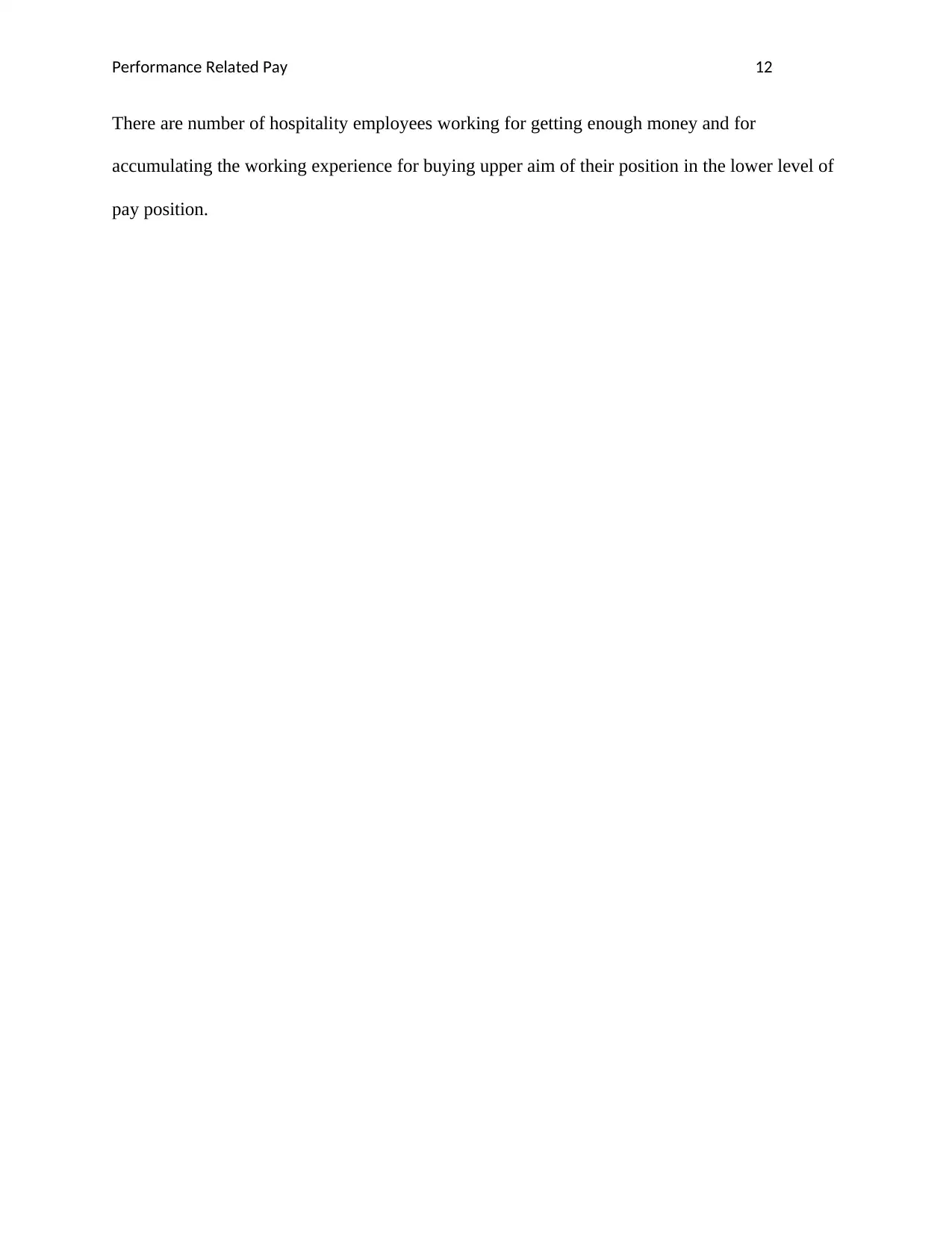
Performance Related Pay 12
There are number of hospitality employees working for getting enough money and for
accumulating the working experience for buying upper aim of their position in the lower level of
pay position.
There are number of hospitality employees working for getting enough money and for
accumulating the working experience for buying upper aim of their position in the lower level of
pay position.
⊘ This is a preview!⊘
Do you want full access?
Subscribe today to unlock all pages.

Trusted by 1+ million students worldwide
1 out of 16
Related Documents
Your All-in-One AI-Powered Toolkit for Academic Success.
+13062052269
info@desklib.com
Available 24*7 on WhatsApp / Email
![[object Object]](/_next/static/media/star-bottom.7253800d.svg)
Unlock your academic potential
Copyright © 2020–2025 A2Z Services. All Rights Reserved. Developed and managed by ZUCOL.





